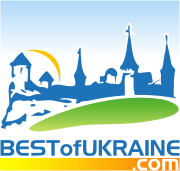Geographical review
Cherkasy (in Ukrainian) or Cherkassy (in Russian) is a city in central Ukraine, the capital of the Cherkasy oblast (region) and the administrative center of Cherkasky Raion (district) within the oblast. It is divided into 2 boroughs (raions) - Sosnivskiy and Pridniprovskiy.
Cherkasy is located in about 200 km (124 mi) south from Kyiv, the capital of Ukraine on the right bank of Dnieper River (at the Kremenchuk Reservoir). The current population is 287,583 (2011). The city occupies an area of 69 km (42.87 mi), it's length is 17 km (10.56 mi) along the Kremenchuk Reservoir, while its width is only 8 km (4.97 mi). From the North-West Cherkasy is surrounded by forest, known as Cherkaskiy Bir, which is the biggest (28,500 hectares) natural pine forest in Ukraine. The major part of Cherkasy is lowlands. Relief of the historical part of the city was influenced by Zamkova (Castle) mountain, where Cherkasy Fortress was situated.
Cherkasy is the cultural, educational and industrial center of Cherkasy Oblast and Central Economical Region of Ukraine. The city is known since the 13th century and played a great role in the history of Ukraine. Cherkasy was the cradle of the Ukrainian Cossack movement. In June 2011, the city celebrated its 725 anniversary.
A little bit of the history
The history of Cherkasy has not been thoroughly explored yet. The year of establishment is considered to be 1286. The first record about Cherkasy was made in 1305 and was found in the Gustynskiy Chronicle, which is the Ukrainian chronicle. The city was one of the centers of the Cossack movement. Citizens took part in Khmelnychchyna and Koliyivschyna (cossacks and peasants rebellions).
Starting from 1360s, the city becomes a part of Grand Duchy of Lithuania and that makes the city an important defender of Southern borders. During 15th-16th centuries, Cherkasy was one of the main centers that helped Cossacks in population of Ukrainian South. Citizens took part in military marches against Tatars and Turkish, including operations led by Ivan Pidkova. New Cherkasy Castle, rebuilt in 1549-52, was the center of city life.
After Union of Lublin in 1569 Cherkasy became a part of Poland. In 1625 Cherkasy Regiment was created and until 1686 it was one of the most powerful military units, which took part in all battles for Bohdan Khmelnytsky army. But after several unsuccessful Cossack attacks against Poland, Bogdan Khmelnytsky had to sign a union with Russian Empire. Signing supposed to be held in Cherkasy, but because of the Polish invasion, diplomats had to move to Pereyaslav, where Pereyaslivska Rada was held. After Pereyaslivska Rada, Cherkasy became a part of Poland for a long time. Only in 1791 the city gained Magdeburg rights.
In 1793, Cherkasy became a part of Russian Empire and since 1797 it was a town of Kiev Governorate. Since the beginning of XIX century Cherkasy was planned by Russian architect, William Heste, civil engineer of Scottish descent. He has developed a general plan of the city, which included building of the square blocks with straight streets.
In the second half of XIX century the city experienced a great economical growth: the railroad and a lot of new industrial enterprises were built. Sugar, tobacco, metalwork, mechanical engineering and trade industries were at their rise.
Later the city was influenced by the cruel social and economical experiments of Soviet authorities and World War II. After October revolution in 1917 Cherkasy got under the rule of bolshevikis, later it was conquered by hetman Pavlo Skoropadskyi, then again by bolshevikis, and later by Nikifor Grigoriev. On January 1, 1920, Cherkasy got under Soviet rule. In 1932-1933 the city was a victim of man-made famine (Holodomor) and in 1936–1938 of a Great Purge (a series of campaigns of political repression and persecution, organised by Joseph Stalin).
During the Second World War Cherkasy was seriously destroyed. On June 22, 1941, German bombers attacked the city. On December 14, 1943, Cherkasy was set free from German invaders. In 1954, the city became the administrative center of Cherkasy Oblast (province), the youngest oblast of Ukraine.
City and economic review
In 1960s Cherkasy became the chemical giant of Ukrainian SSR. Several plants have been built in the city: "Azot" (the biggest nitrogen fertilizer producing plant), "Himvolokno" (artificial fiber manufacturing plant), "Himreaktyv" (chemical reagents for military purposes) and others. In 1961 a Kremenchuk hydro power plant was built, forming Kremenchuk Water Reservoir. This made the city a big transport hub, serving the longest dyke in Ukraine (15 km) with rail and road on it.
Though, like in other Ukrainian cities, after gaining the independence, the industry in Cherkasy has started to decline, along with the number of city population and level of life. A lot of big and powerful factories and plants were privatized but couldn't survive on competitive market. Some enterprises changed their structure and production. Several factories and plants were united under the "Bogdan Corporation" and started the production of buses and cars. Some of the companies managed to stay alive and became successful, for example, "Azot" plant.
In 2009, Cherkasy airport got the status of International Airport (IATA: CKC – ICAO: UKKE).




